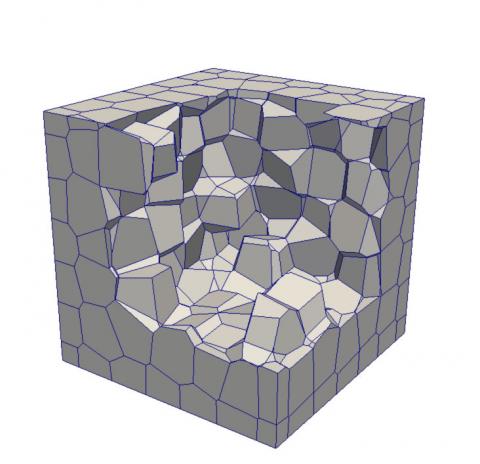
A research partnership with EDF
Inspect the structural integrity of materials without destroying them; such is the aim of the non-destructive testing (NDT) procedures used by industrials to assess the reliability of their most critical facilities. This is also the focus of the new HIPOTHEC project, involving two R&D engineers from EDF and two researchers from the Rapsodi project-team of the Lille University INRIA Centre - a joint INRIA / Lille University / CNRS entity.
‘Our research focuses on the non-destructive testing of metal tubes in steam generators, such as those used in the primary circuit of nuclear plants’, explains Simon Lemaire, research fellow within the project-team since 2018. The team specialises in the numerical simulation of dissipative phenomena (porous media flows, corrosion, etc.). ‘ In HIPOTHEC we explore new numerical methods to simulate electromagnetic phenomena.’
The consortium is being subsidised by the National Research Agency (ANR) since mid-2022, in the framework of the France Relance recovery plan. This has enabled the funding of an initial 2-year post-doctoral position, filled by Italian researcher Silvano Pitassi hired in October 2022. An application for additional co-research funding, reserved for projects involving the R&D department of at least one French company, is currently being examined by the ANR. If obtained, this 5-year subsidy would enable Rapsodi and EDF to fund, within an enlarged consortium, two PhDs and two additional post-doctorates.
Eddy currents and polyhedral meshes
The HIPOTHEC (HIgh-order POlyhedral meTHods for Eddy Current testing simulations) project is concerned with the simulation of NDT via eddy currents. In addition to ultrasound NDT, eddy current testing forms one of the main techniques used by EDF to ‘scan steel’, says Jérémy Dalphin, research engineer within the ERMES department (Electrical Engineering and Structural Mechanics) at EDF R&D.
How does non-destructive eddy current testing work? ‘We position a sensor in the vicinity of the metal tube, which induces eddy currents (electromagnetic induction)’, Jérémy Dalphin explains. ‘This generates electromagnetic fields, which may be disrupted by the presence of irregularities (elements requiring further inspection). We measure these disruptions in order to characterise the anomalies.’
In order to simulate a physical problem using a computer, first ‘you need to discretise it, in other words, cut it into pieces’, Simon Lemaire tells us. In practice, the computational domain is divided into small pieces, which form what is known as a mesh. The numerical methods studied in the HIPOTHEC project are polyhedral methods, which can naturally accommodate meshes with cells of very general geometrical shapes. This geometric flexibility greatly simplifies the tesselation of the computational domain, enabling the modeling of complex defects within the structure. ‘It is also easier, in the polyhedral context, to increase very locally the resolution, in the vicinity of those tube sections where anomalies have been detected’, Jérémy Dalphin points out.
Another feature of the numerical methods studied in the HIPOTHEC project is their high-order accuracy. ‘These high-order methods allow us to increase the precision of a simulation for a given mesh size’, says Jean-Pierre Ducreux, research engineer within the ERMES department at EDF R&D, which contributes to the development and validation of innovative computational methods for the study of electrical equipment.
Industrial transfer
Non-destructive testing is of high strategic interest for EDF. The simulation codes currently used by EDF for eddy current testing can still be improved in two ways: the precision of the numerical methods implemented therein, and the geometrical flexibility of the admissible meshes. ‘The goal of the HIPOTHEC project is to verify whether the new numerical simulation methods under development could one day be integrated into the industrial codes used by EDF for the non-destructive testing of steel tubes’, Simon Lemaire reveals.
The first step will be to develop a prototype simulation code (outside of the industrial circuit). To achieve this, the EDF researchers will bring their expertise in practical and representative case studies while the Rapsodi researchers will focus on the design and mathematical analysis of the algorithms. The simulator will then require extensive testing prior to potentially obtaining validation and certification for industrial use by the EDF group.
‘EDF’s ERMES R&D department maintains leading expertise in the field of electro-technical modeling. HIPOTHEC forms part of this endeavor: polyhedral meshes offer an innovative solution to the key challenges posed by the eddy current testing of steam generator metal tubes in nuclear power plants.’
Jean-Pierre Ducreux, research engineer within the ERMES department (Electrical Engineering and Structural Mechanics) at EDF R&D
‘Part of my research deals with non-destructive testing. With the HIPOTHEC project, we aim at designing new numerical methods for the simulation of electromagnetic phenomena. These methods should facilitate the non-destructive testing of steel tubes. We also hope to be able to model more precisely complex cracks.’
Jérémy Dalphin, research engineer within the ERMES department at EDF R&D.
Find out more (in French)
- Le contrôle des pièces par courants de Foucault, MetalBlog, 3/6/2019.
- Les mathématiques appliquées à la recherche des défauts de structures, Inria, 23/3/2023.
- De l'imagerie médicale à l'inspection des grands ouvrages, Inria, 6/3/2023
- EDF et Inria renforcent leur partenariat pour accélérer la transition énergétique grâce au numérique, Inria, 16/6/2022

